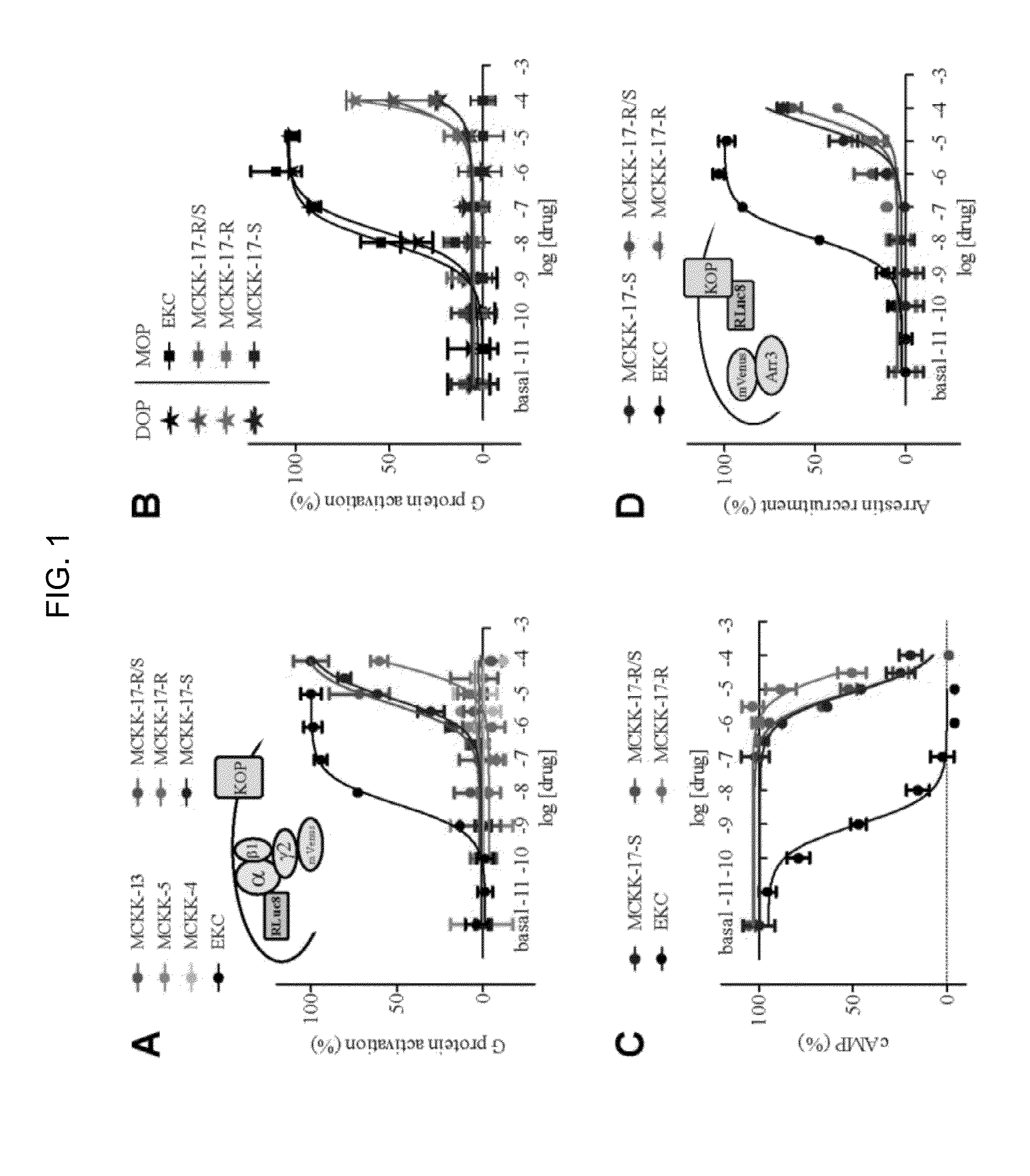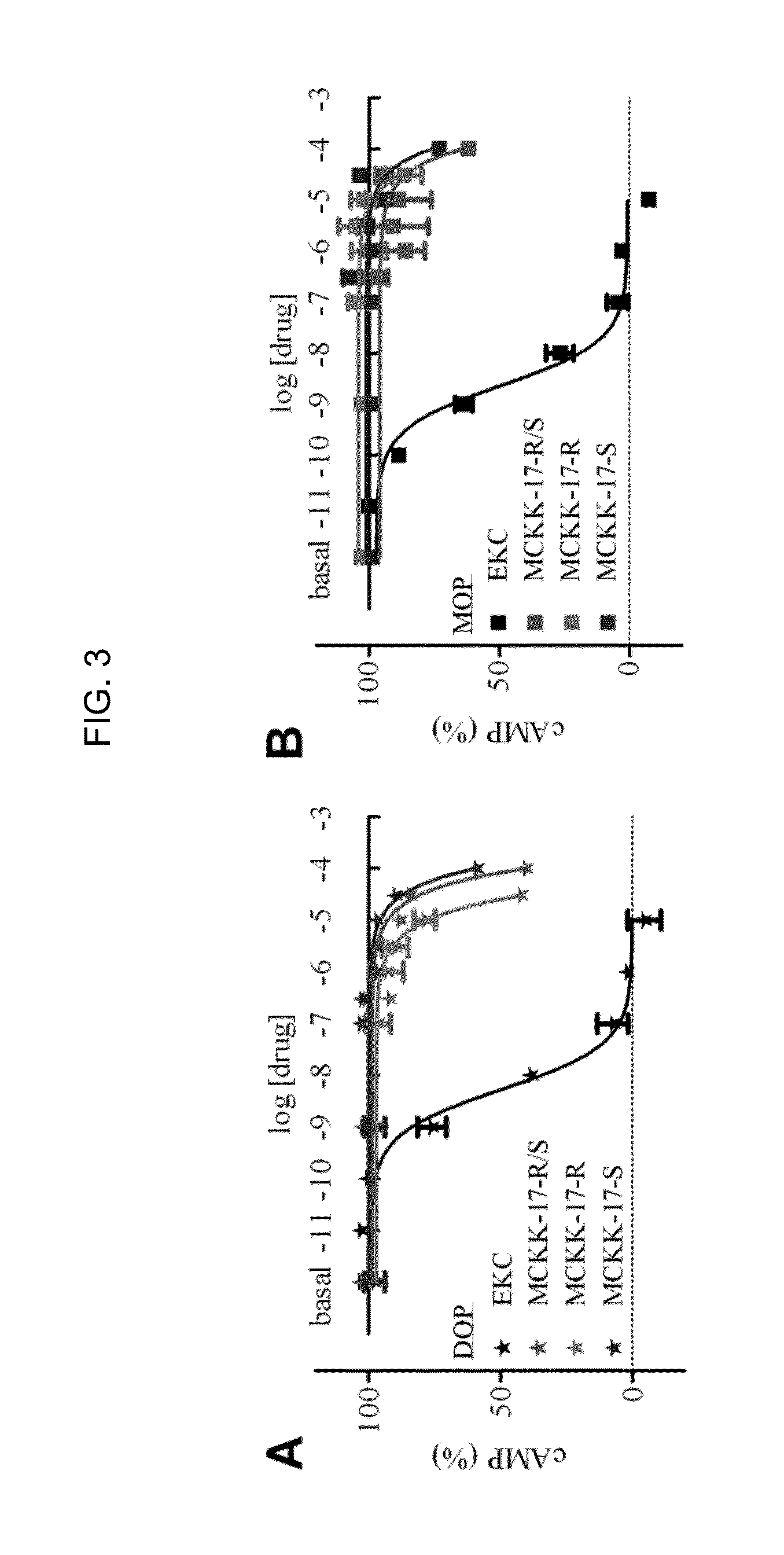Kappa opioid receptor selective compounds, compositions, and uses thereof
a selective compound and opioid receptor technology, applied in the field of kappa opioid receptor selective compounds, compositions, can solve the problems of limiting the effective use affecting the clinical effect of patients, and limiting the physicochemical properties of kop receptor agonists developed to date, so as to improve the effect of pain, treating or ameliorating the effects of a condition, and reducing the number of side effects
- Summary
- Abstract
- Description
- Claims
- Application Information
AI Technical Summary
Benefits of technology
Problems solved by technology
Method used
Image
Examples
example 1
Materials and Methods
Small-Molecule Subset, Docking, Selection, and Novelty
[0139]The inventors used the lead-like′ subset version of the ZINC database (Irwin et al., 2005) that was accessible online on Feb. 2, 2012, when the molecular docking study was initiated. This subset version contained about 4.5 million commercially available small-molecules selected using the filtering criteria specified on the ZINC database website. Molecular docking at chain A of the recently released inactive KOP receptor structure (PDB ID: 4DJH (Wu et al., 2012)), following removal of all non-protein atoms, was performed with DOCK3.6 (Lorber et al., 1998; Lorber et al., 2005; Kuntz et al., 1982; Mysinger et al., 2010). The atom positions of the JDTic crystallographic ligand within the KOP receptor binding pocket were replaced by forty-five spheres that had been labeled for chemical matching based on the local protein environment. Default parameters, i.e., a bin size of 0.2 Å, a bin size overlap of 0.1 Å,...
example 2
Structure-Based Identification of Novel Chemotypes Targeting the KOP Receptor
[0151]4,554,059 commercially-available, “lead-like” compounds from the ZINC database (Irwin et al., 2005) were screened in silico based on complementarity with the crystallographic binding mode of JDTic into the KOP receptor binding pocket. The 500 top-scoring docking hits (FIG. 4; 0.01% of the docked library) were visually inspected and prioritized based on features that an automatic molecular docking screen does not take into account. Specifically, molecules were selected based on the following criteria: a) chemotype diversity; b) the presence of polar interactions between the ligand and the Asp1383.32 residue; c) interactions with KOP receptor residues in the binding pocket that are different in DOP and MOP receptors, d) limited flexibility, e) different binding modes from classical alkaloids as revealed by DOP (Granier et al., 2012) and MOP (Manglik et al., 2012) receptor crystal structures, and f) purc...
example 3
One of the Top-Scoring Docked Molecules is a Selective Agonist at the KOP Receptor
[0152]The primary experimental testing of MCKK-1-22 consisted of performing a competitive inhibition binding assay at the hKOP receptor. Membranes of HEK293T cells transfected with the hKOP receptor and GαoB were prepared and incubated with 3H-diprenorphine (0.3 nM) in the absence or presence of 10 or 100 μM of each small-molecule from the virtual screening. Four molecules, MCKK-4, MCKK-5, MCKK-13 and MCKK-17 partially but significantly inhibited 3H-diprenorphine binding (FIG. 2) at 100 μM and their properties were therefore further investigated.
[0153]To assess whether any of these molecules had agonistic activity, a BRET-based G protein activation assay where the hKOP receptor was co-expressed in HEK293T cells with GαoB-RLuc8, β1, and mVenus-γ2 was used. The drug-induced BRET signal is interpreted as a dissociation of and / or conformational change within the Gαβγ complex, and thus, as the activation of...
PUM
| Property | Measurement | Unit |
|---|---|---|
| volume | aaaaa | aaaaa |
| pH | aaaaa | aaaaa |
| particle size | aaaaa | aaaaa |
Abstract
Description
Claims
Application Information
 Login to View More
Login to View More - R&D
- Intellectual Property
- Life Sciences
- Materials
- Tech Scout
- Unparalleled Data Quality
- Higher Quality Content
- 60% Fewer Hallucinations
Browse by: Latest US Patents, China's latest patents, Technical Efficacy Thesaurus, Application Domain, Technology Topic, Popular Technical Reports.
© 2025 PatSnap. All rights reserved.Legal|Privacy policy|Modern Slavery Act Transparency Statement|Sitemap|About US| Contact US: help@patsnap.com



